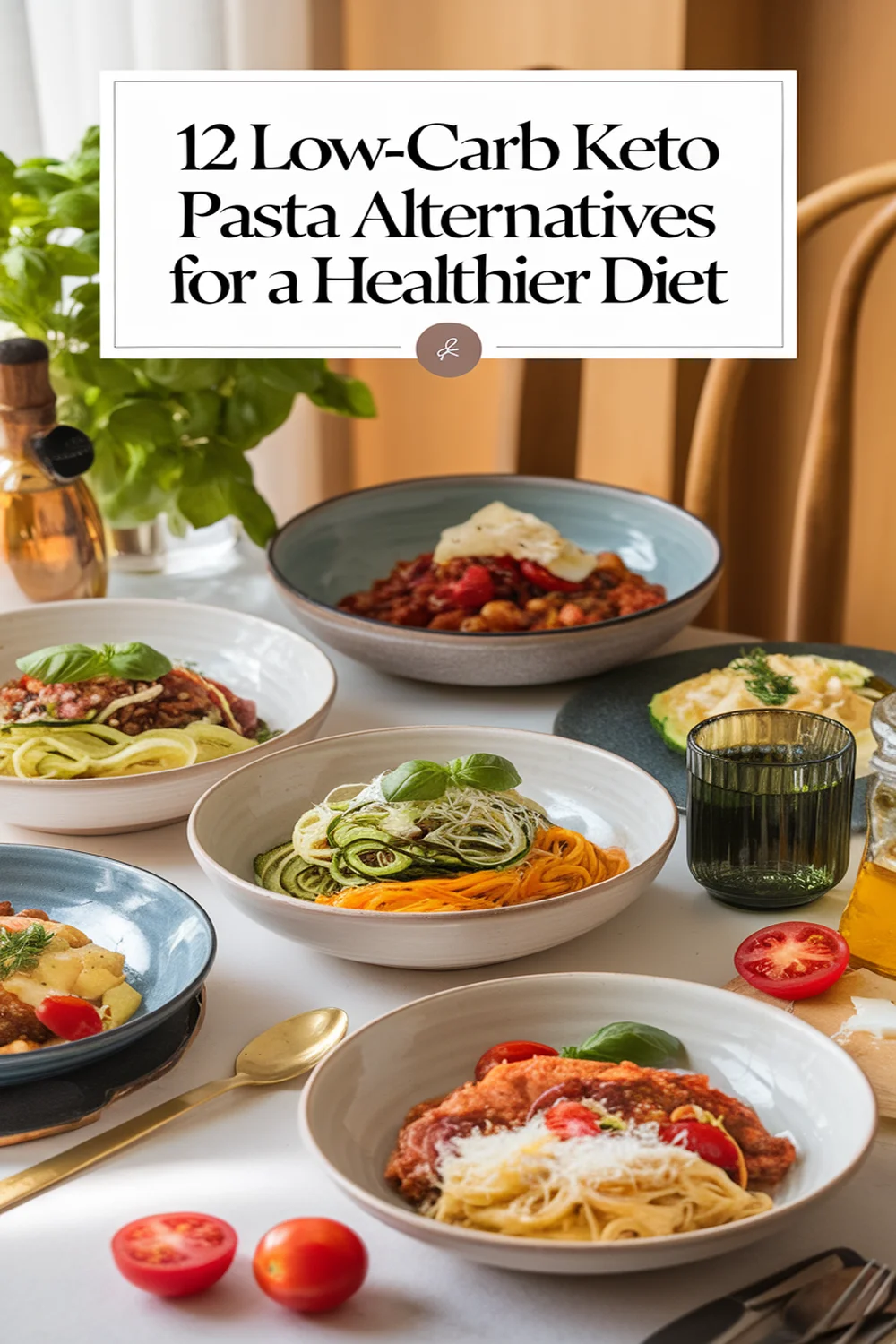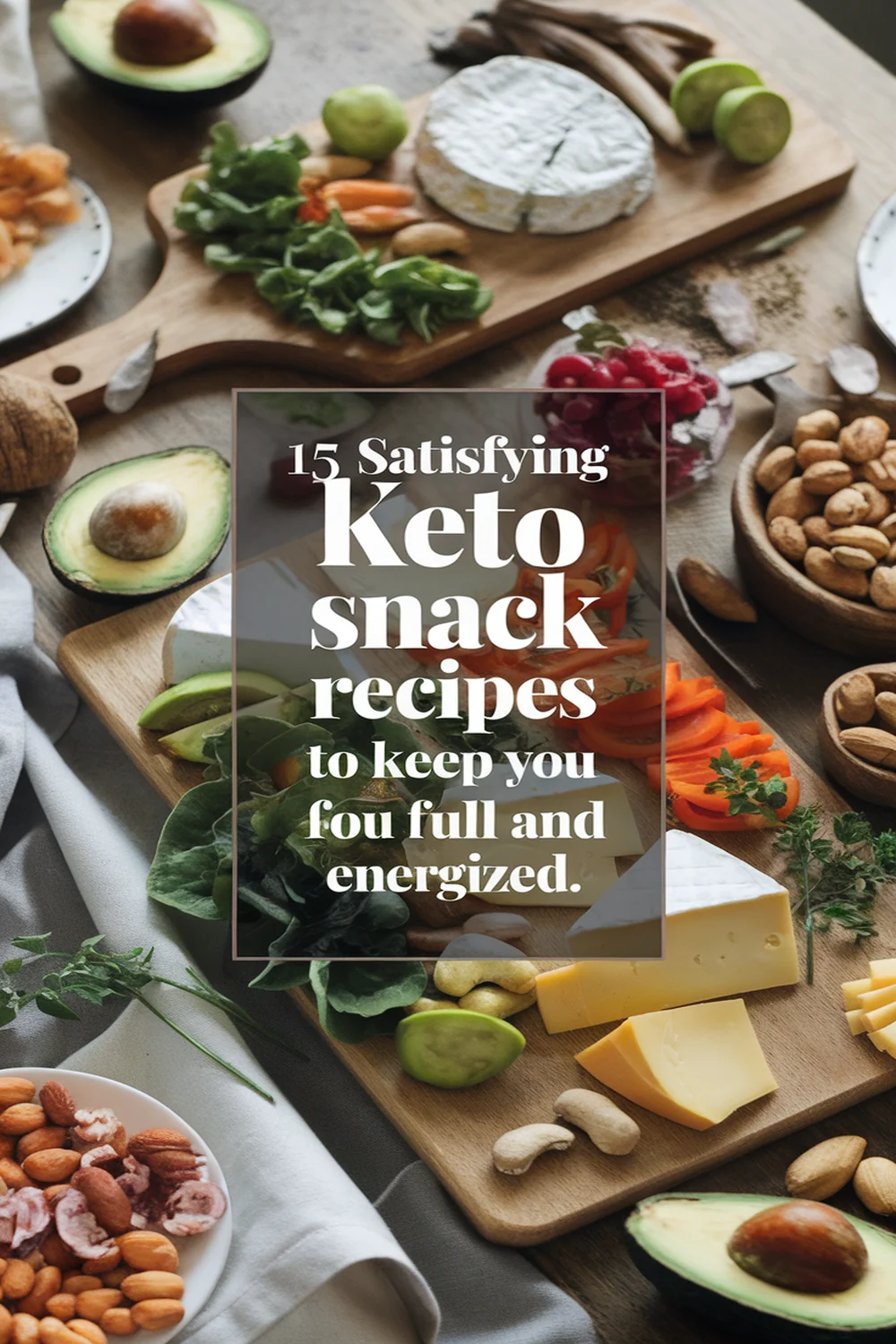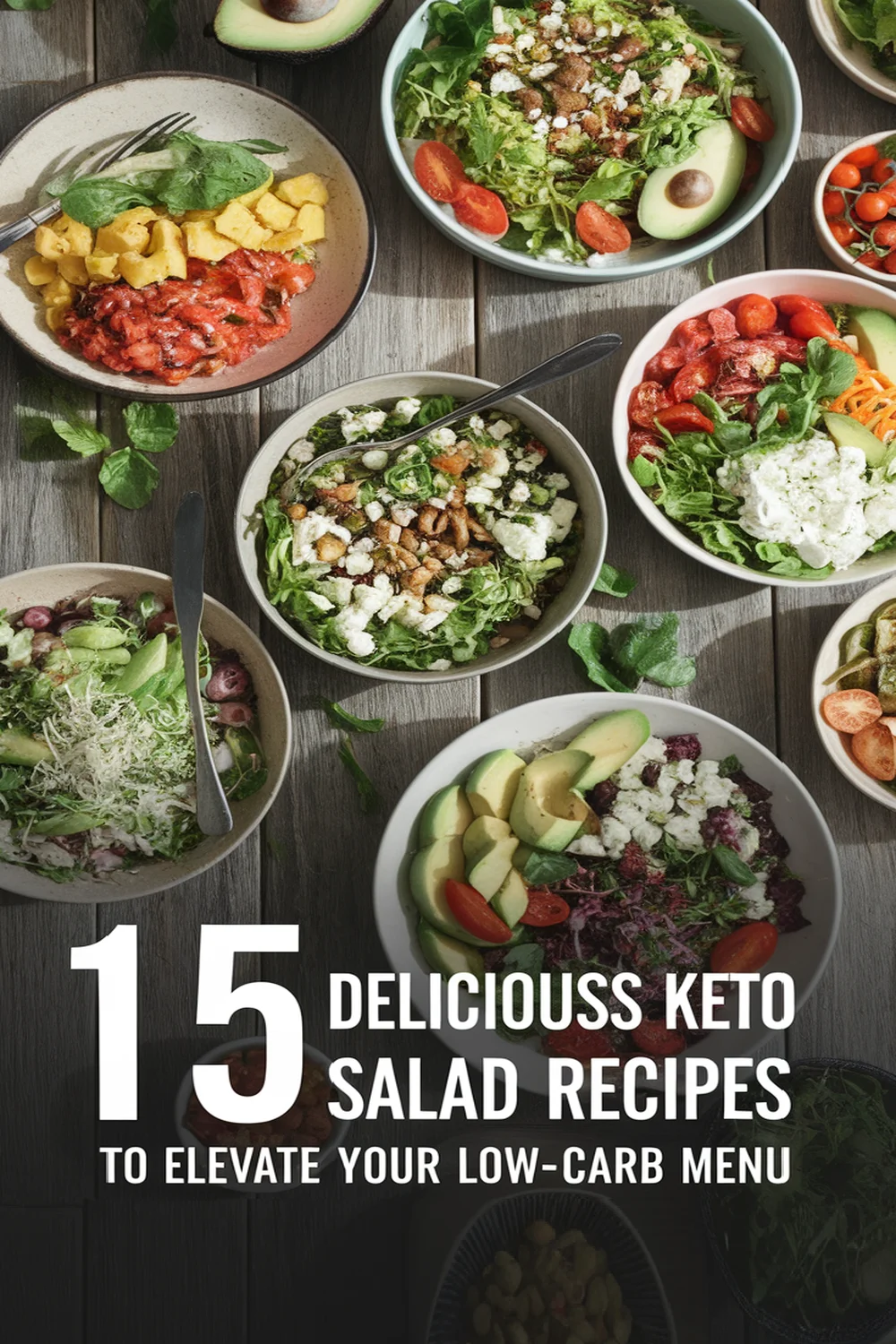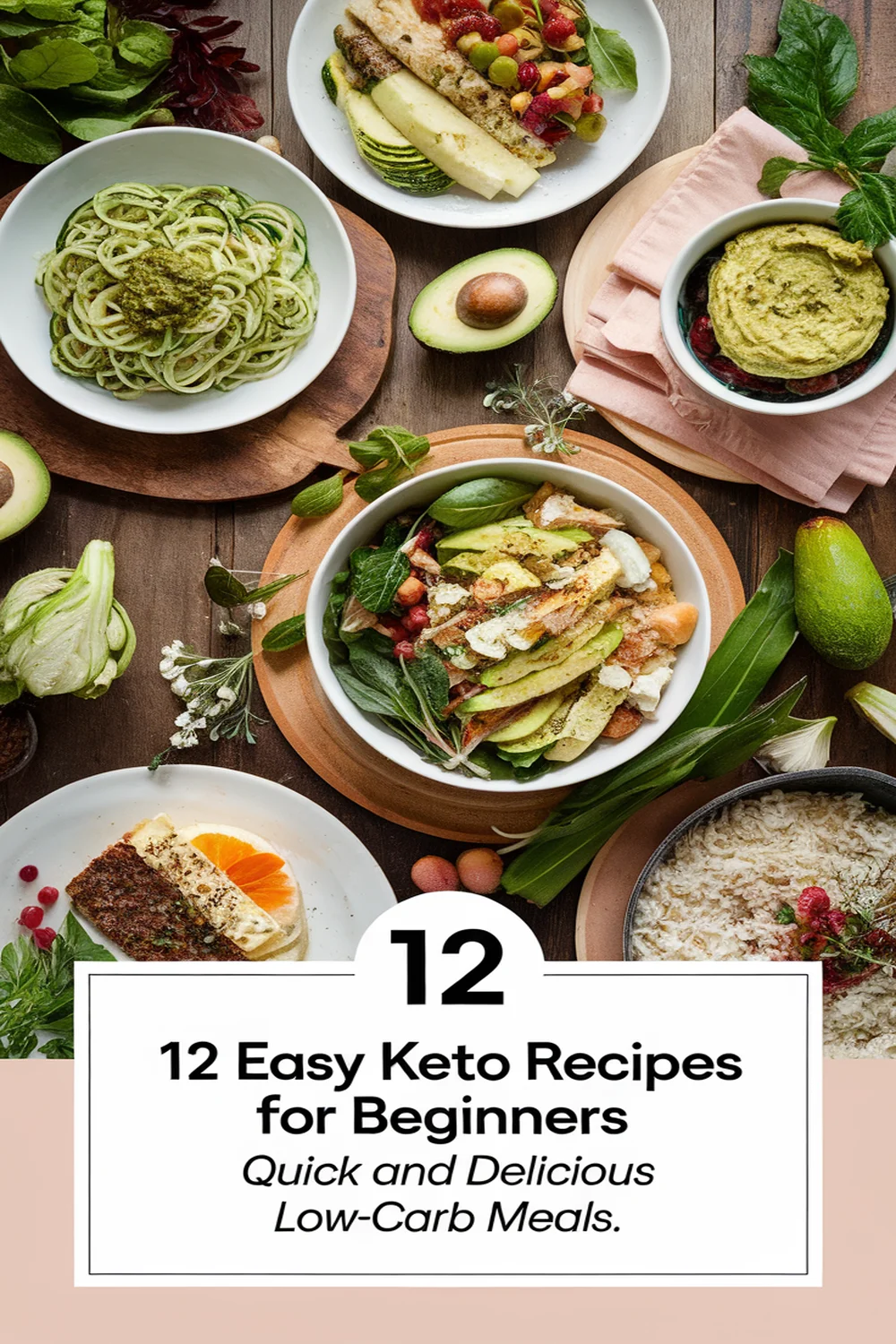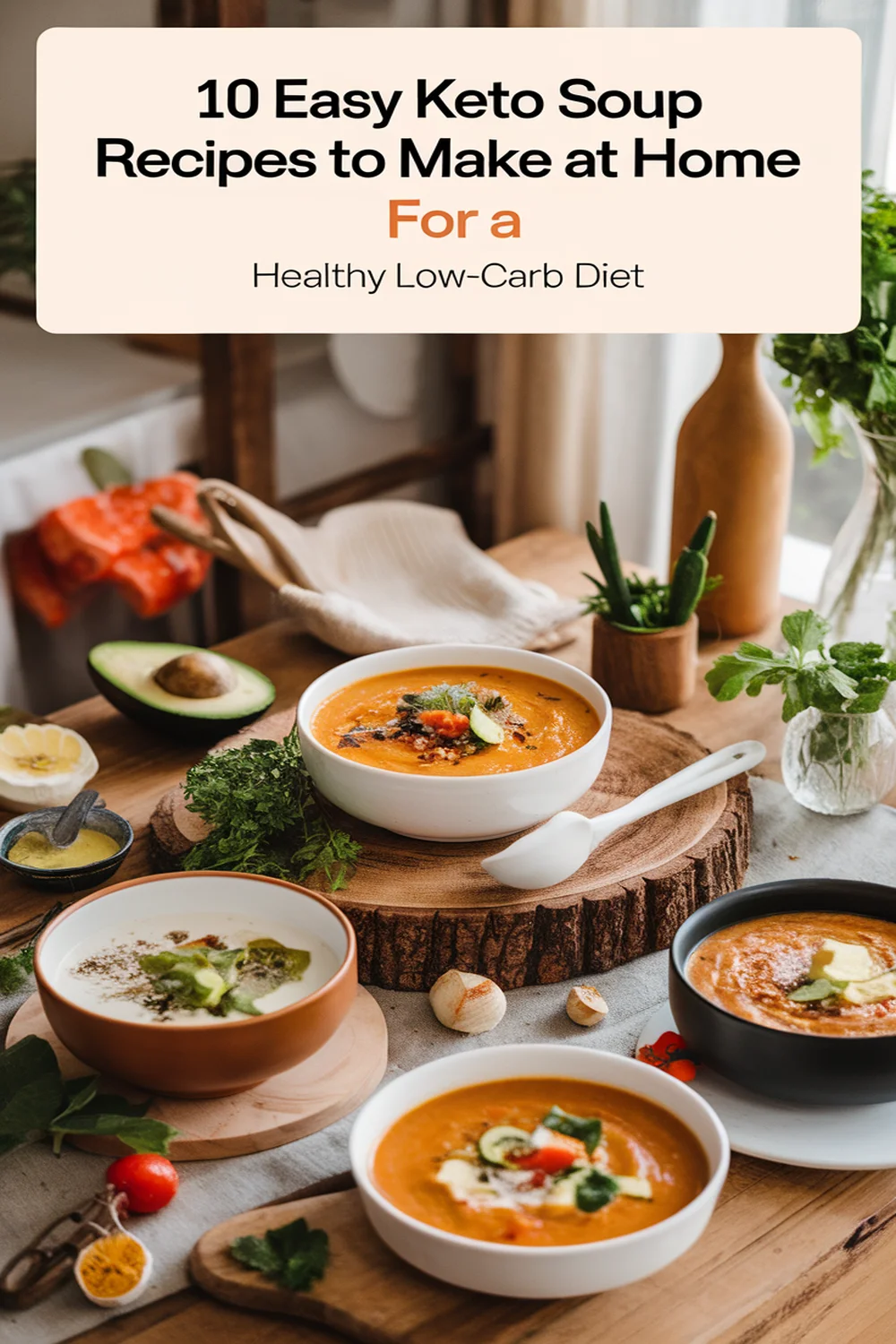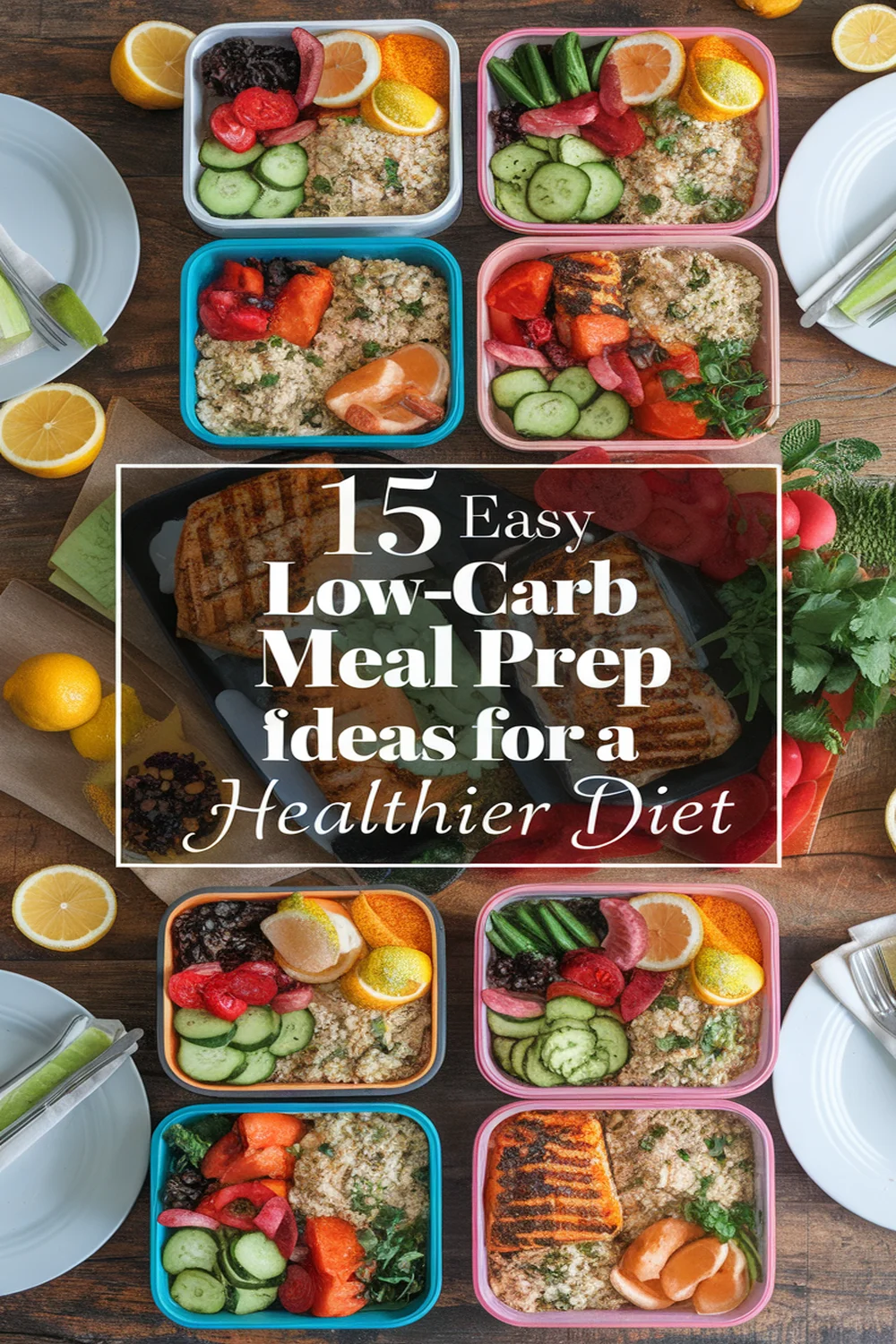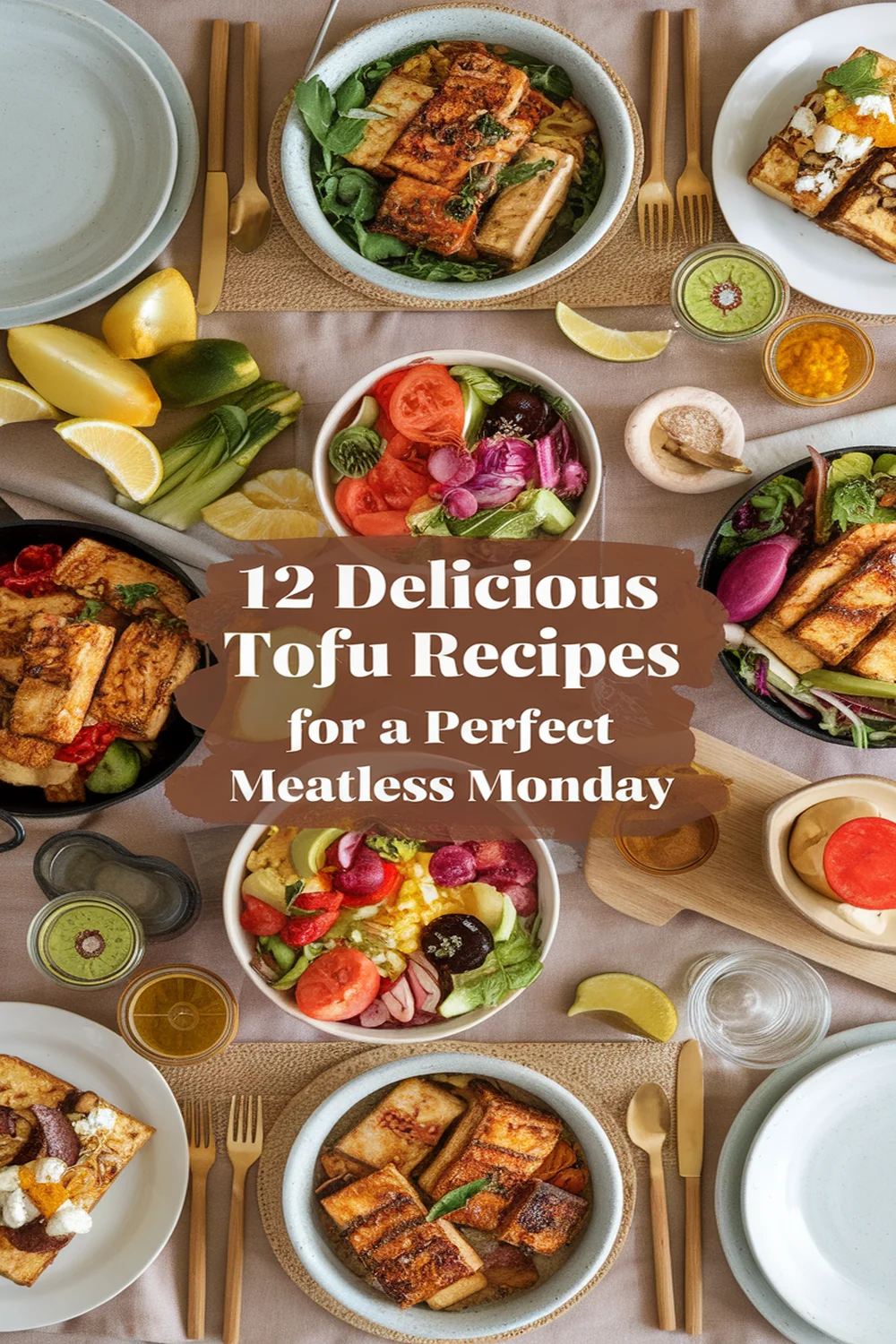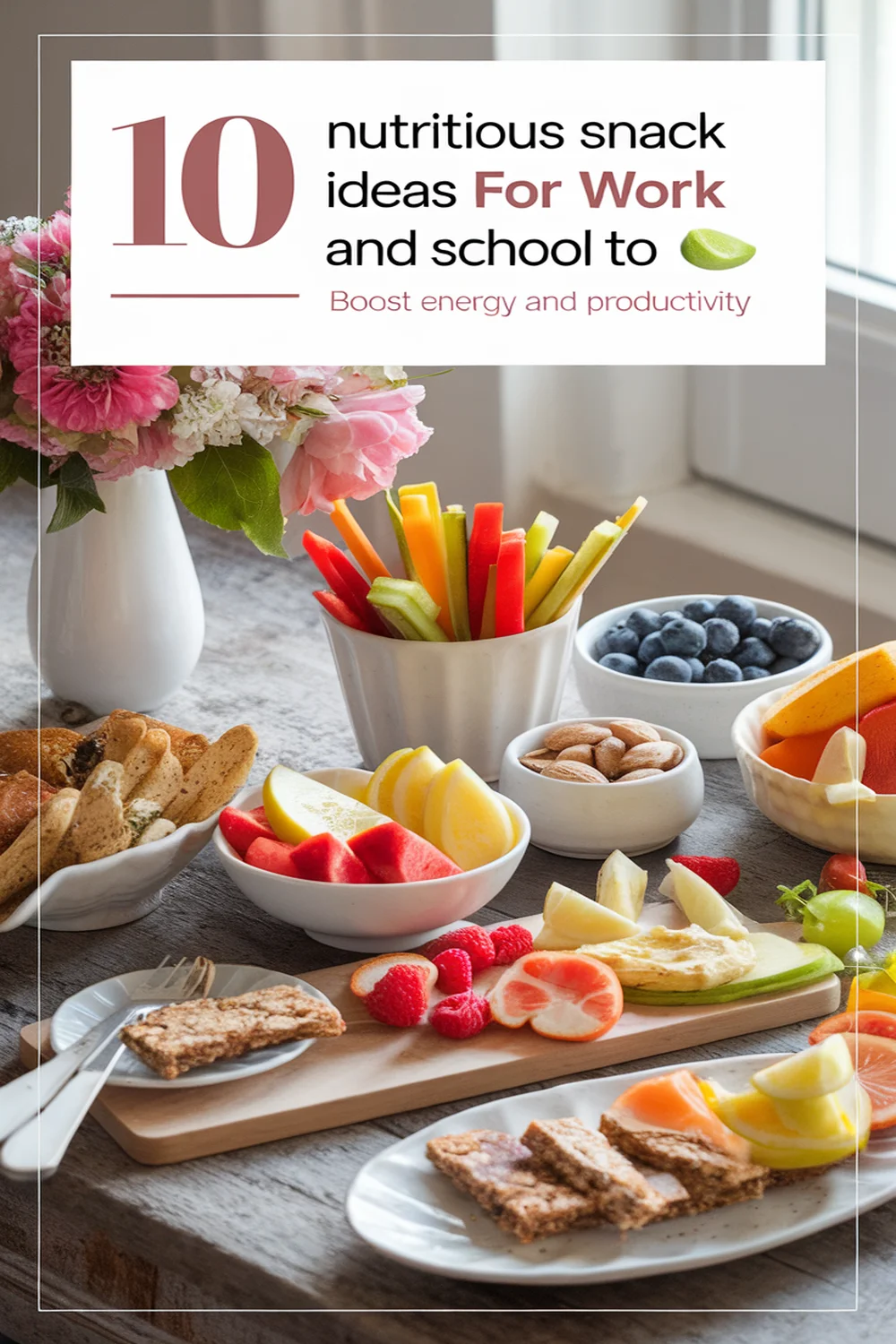This post may contain affiliate links. Please read our policy page.
When it comes to low-carb keto pasta alternatives, you’ve got great options. Zucchini noodles (zoodles) and shirataki noodles are versatile and low in calories. Spaghetti squash offers spaghetti-like strands, while cauliflower rice serves as a rice substitute. Palmini pasta, broccoli noodles, and kelp noodles provide unique textures and flavors. For more protein, consider chickpea or protein pasta. These alternatives can help you enjoy your favorite dishes without the carbs, and there’s even more to explore.
Zucchini Noodles
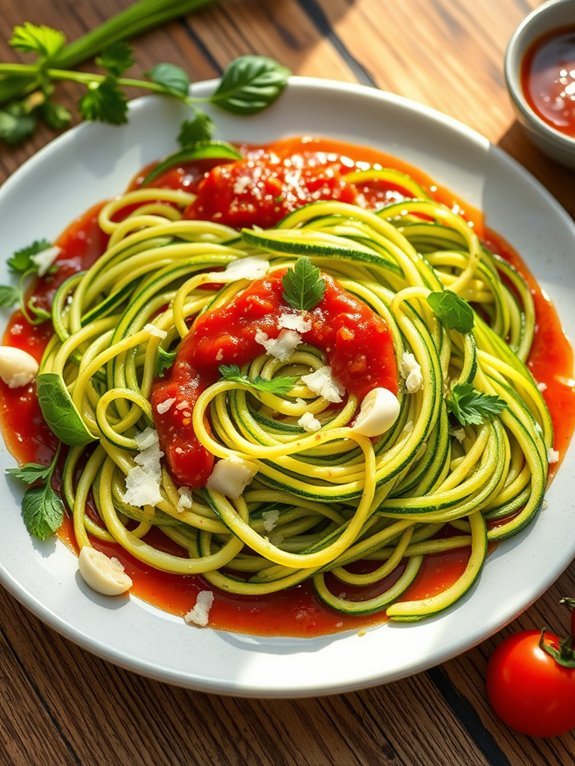
Zucchini noodles, also known as “zoodles,” are a wonderfully versatile alternative to traditional pasta, making them a perfect choice for those following a low-carb or keto diet. They aren’t only low in calories but also packed with vitamins and minerals, making them a nutritious addition to any meal.
The light, fresh flavor of zucchini pairs well with a variety of sauces and toppings, allowing you to relish your favorite pasta dishes without the carbs.
Making zucchini noodles is simple and requires minimal cooking, making it an ideal meal for busy weeknights. With the right tools, you can spiralize fresh zucchini into delicate noodles in just a few minutes. Whether you choose to sauté them lightly or serve them raw, zucchini noodles can create satisfying, guilt-free options for pasta lovers.
- 2 medium-sized zucchinis
- 1 tablespoon olive oil
- 1/2 teaspoon salt
- 1/4 teaspoon black pepper
- 1/2 teaspoon garlic powder (optional)
- Fresh basil or parsley (for garnish)
- Your choice of sauce (e.g., marinara, pesto, alfredo)
To prepare zucchini noodles, begin by washing and trimming the ends of the zucchinis. Use a spiralizer or a julienne peeler to create long, noodle-like strands from the zucchini.
Heat olive oil in a skillet over medium heat, then add the zucchini noodles, sprinkling with salt, pepper, and garlic powder if desired. Sauté for about 3-5 minutes, or until the noodles are slightly tender but still have a bit of crunch. Serve immediately with your favorite sauce and garnish with fresh herbs.
When cooking zucchini noodles, it’s important not to overcook them, as they can become mushy and lose their texture. If you prefer a firmer noodle, you can also opt to blanch them briefly in boiling water instead of sautéing.
Additionally, you may want to take into account using a paper towel to pat the cooked zoodles dry to remove excess moisture, preventing sogginess. Enjoy experimenting with different sauces and toppings to find your perfect zucchini noodle combination!
Recommended Items
Discover our top picks for delicious low-carb pasta alternatives and the essential tools to make cooking a breeze!
Shirataki Noodles
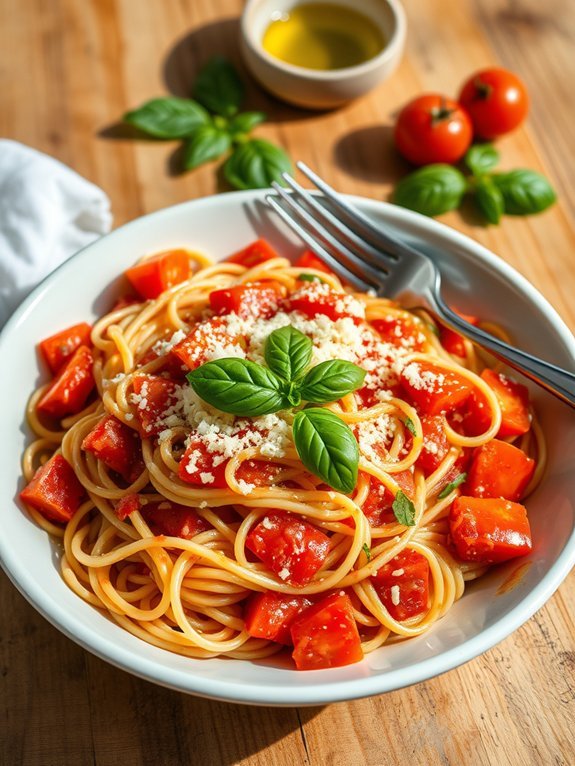
Shirataki noodles are a fantastic low-carb, keto-friendly alternative to traditional pasta. Made from the konjac yam, these noodles are virtually calorie-free and rich in glucomannan, a type of soluble fiber that promotes digestive health and satiety. They’re an excellent base for a variety of sauces and toppings, allowing you to enjoy your favorite pasta dishes without the carbs.
Cooking with Shirataki noodles is simple and quick, making them a great choice for weeknight meals. These noodles have a slightly unique texture, so a little extra preparation can help enhance their taste and make them even more enjoyable. Whether you’re tossing them with a homemade marinara sauce or a creamy alfredo, Shirataki noodles will deliver on flavor while keeping your carb count low.
- 1 package of Shirataki noodles
- 1 tablespoon olive oil
- 2 cloves garlic, minced
- 1/2 cup diced tomatoes (fresh or canned)
- 1/2 teaspoon dried basil
- 1/2 teaspoon dried oregano
- Salt and pepper, to taste
- Grated Parmesan cheese (optional, for serving)
Start by draining the Shirataki noodles and rinsing them under cold water for about 2-3 minutes. In a skillet, heat the olive oil over medium heat, add the minced garlic, and sauté until fragrant.
Add the Shirataki noodles, diced tomatoes, basil, and oregano, cooking for about 5-7 minutes while stirring occasionally until everything is heated through. Season with salt and pepper to taste, and serve hot, garnished with grated Parmesan cheese if desired.
When cooking Shirataki noodles, it’s important to thoroughly rinse and dry them to remove any odor they may have from packaging. For an even better texture, consider pan-frying the noodles for a few minutes after drying them to help absorb flavors.
Feel free to customize the dish by adding vegetables, proteins, or your favorite sauces to make it your own!
Spaghetti Squash
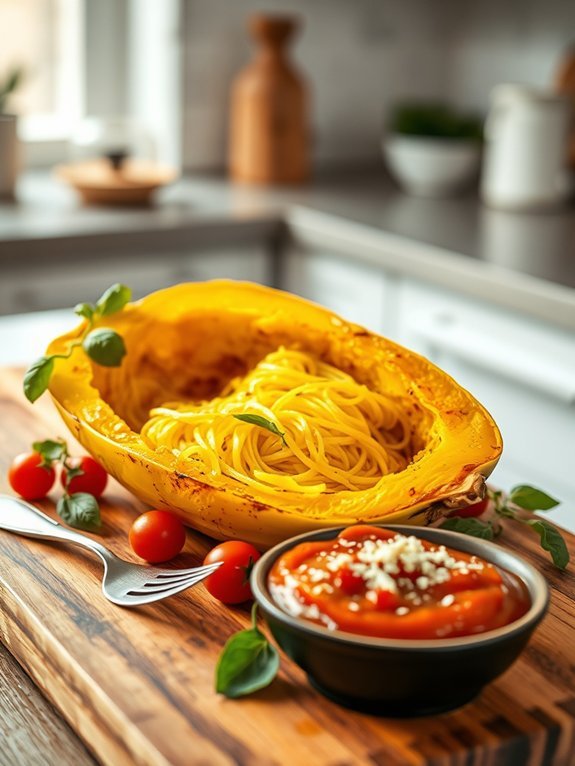
Spaghetti squash is a fantastic low-carb alternative to traditional pasta, making it a popular choice for those following a ketogenic or low-carb lifestyle. When cooked, the flesh of the squash transforms into spaghetti-like strands, providing a perfect vehicle for your favorite sauces and toppings. This versatile vegetable isn’t only easy to prepare but also packed with nutrients, making it a nutritious addition to your meals.
To cook spaghetti squash, you’ll want to take into account both the classic roasted method and a quicker microwave option, depending on your available time. Roasting brings out a delicious caramelized flavor and guarantees a softer texture, while microwaving is ideal for a fast, weeknight dinner. Whichever method you choose, you’ll love how well spaghetti squash complements various sauces, from marinara to Alfredo, making it a wonderful canvas for culinary creativity.
Ingredients:
- 1 medium spaghetti squash
- Olive oil
- Salt
- Black pepper
- Optional seasonings (e.g., garlic powder, Italian herbs)
Cut the spaghetti squash in half lengthwise and scoop out the seeds. Drizzle olive oil on the cut sides, then sprinkle with salt, pepper, and any additional seasonings you prefer.
Place the squash cut-side down on a baking sheet and roast in a preheated oven at 400°F (200°C) for about 30-40 minutes, or until the flesh is tender. Once cooked, carefully scrape the insides with a fork to create spaghetti-like strands.
When choosing a spaghetti squash, look for one that feels firm and heavy for its size, as this indicates freshness. For an extra flavor boost, think about adding herbs or spices directly into the squash before roasting.
If you’re short on time, the microwave option can work well; simply cook the squash in a covered dish with a little water for about 10-12 minutes.
Don’t forget, storing leftovers is simple: just refrigerate the strands in an airtight container for up to a week!
Cauliflower Rice
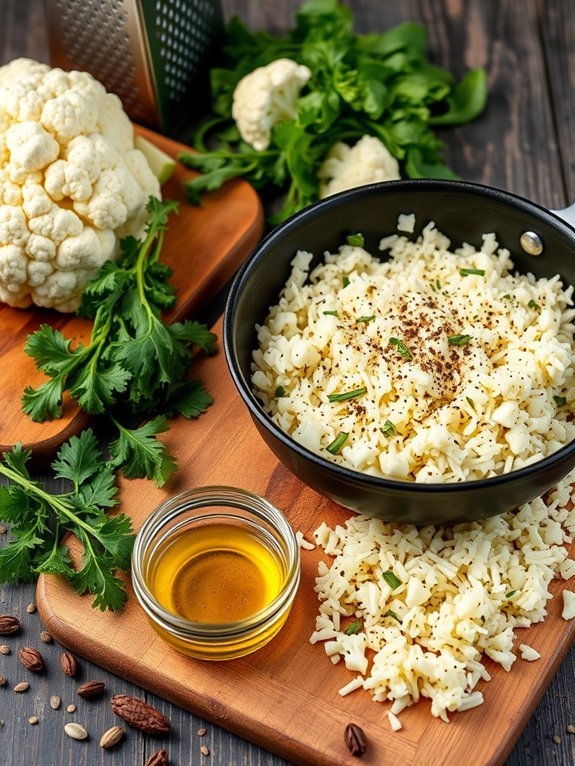
Cauliflower rice is a fantastic low-carb alternative to traditional rice, perfect for those on a ketogenic diet. It’s not only healthy but also versatile, easily absorbing the flavors of your favorite dishes. Making cauliflower rice is simple and can be done in less than 30 minutes, making it an ideal side dish or base for stir-fries, curries, and more.
To prepare cauliflower rice, you start with fresh cauliflower, which is packed with nutrients and low in calories. By grating the cauliflower into fine pieces, you create a rice-like texture that can be sautéed, steamed, or microwaved. This dish is a wonderful way to sneak in more veggies while enjoying your favorite meals without the guilt of traditional carbs.
- 1 medium head of cauliflower
- 1 tablespoon olive oil (or butter)
- Salt, to taste
- Pepper, to taste
- Optional: garlic powder, onion powder, or fresh herbs for flavor
Begin by removing the leaves and stem of the cauliflower, then cut it into florets. Using a box grater, food processor, or blender, pulse the cauliflower until it resembles rice grains.
Heat the olive oil in a large skillet over medium heat, add the cauliflower rice, and sauté for about 5-7 minutes, stirring occasionally, until it becomes tender. Season with salt and pepper (and any additional spices) to taste.
To enhance the flavor and texture of your cauliflower rice, make sure not to overcook it, as it can become mushy. You can also experiment with other herbs and spices like basil or cumin to complement the dish you’re preparing.
If you find yourself with excess cauliflower rice, it can be frozen for about 1-2 months, allowing for easy meal prep in the future. Just make sure to let it cool completely before freezing to retain its freshness. Enjoy your low-carb journey with this delicious pasta alternative!
Palmini Pasta
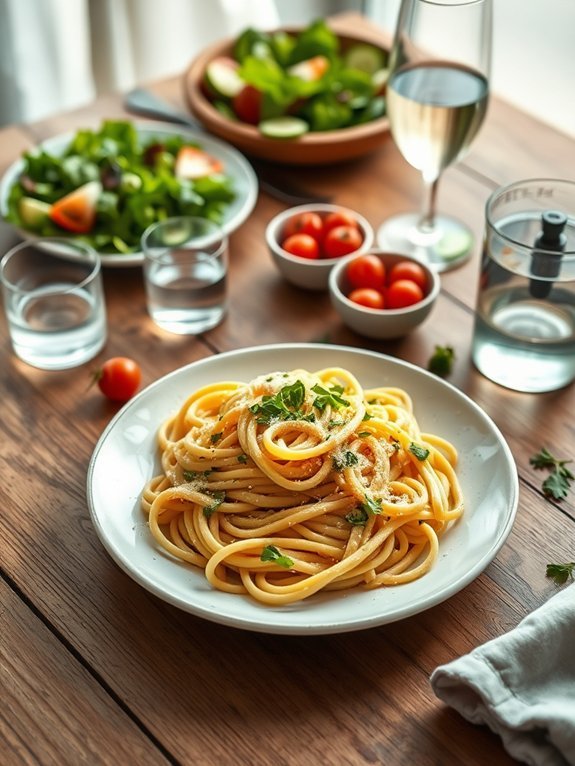
Palmini pasta is a fantastic low-carb alternative for those following a keto diet, and it’s made from hearts of palm. This unique ingredient offers a texture similar to traditional pasta while containing considerably fewer carbohydrates. The subtle flavor of Palmini allows it to absorb the delicious sauces and seasonings you pair it with, making it an excellent base for a variety of dishes.
Whether you’re craving a hearty marinara or a creamy alfredo, Palmini pasta can be a satisfying choice without the guilt of traditional pasta.
Preparing Palmini pasta is quick and easy, making it perfect for a busy weekday meal or a leisurely Sunday dinner. This recipe highlights the versatility of Palmini with a simple garlic and olive oil sauce that enhances its natural flavor while keeping the dish light and keto-friendly. Pair this recipe with a fresh side salad, and you have a complete meal that’s both healthy and delicious.
Ingredients:
- 1 package Palmini pasta
- 2 tablespoons olive oil
- 3 cloves garlic, minced
- 1/4 teaspoon red pepper flakes (optional)
- Salt and pepper, to taste
- Fresh parsley, chopped (for garnish)
- Grated Parmesan cheese (optional)
Cook the Palmini pasta according to the package instructions, which typically involves rinsing and draining it to remove any brine flavor.
In a skillet over medium heat, warm the olive oil. Add minced garlic and red pepper flakes, sautéing for about 30 seconds or until fragrant. Toss in the cooked Palmini pasta, seasoning with salt and pepper, and cook for an additional 2-3 minutes to heat through and allow the pasta to absorb the flavors.
When cooking Palmini pasta, it’s vital to not over-cook it, as the texture can become mushy. Always rinse the pasta thoroughly to reduce the briny taste and enhance its versatility. Feel free to experiment with additional ingredients, such as fresh vegetables or protein, to create your favorite pasta dishes while keeping them low in carbs.
Enjoy your meal!
Konjac Noodles
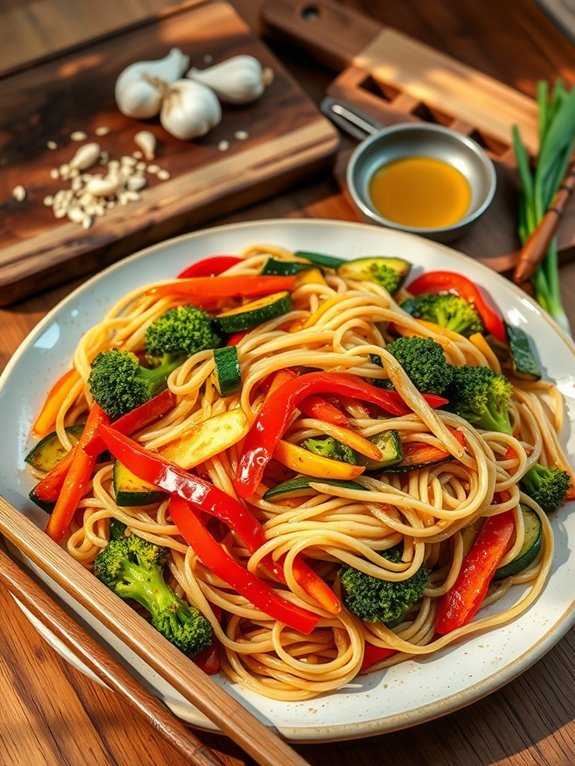
Konjac noodles, often referred to as “shirataki” noodles, are a fantastic low-carb pasta alternative that can satisfy your noodle cravings without the extra carbs that traditional pasta brings. Made from the konjac root, these noodles are primarily composed of water and glucomannan, a type of soluble fiber. They’ve a unique texture and will absorb the flavors of the sauces and ingredients you cook them with, making them a versatile addition to many dishes.
Preparing konjac noodles is incredibly simple, allowing you to whip up a satisfying meal quickly. Due to their mild flavor, they work well in a variety of cuisines, whether you’re going for a creamy alfredo, spicy stir-fry, or classic Italian marinara.
In this recipe, we’ll combine the konjac noodles with a delicious garlic and vegetable stir-fry that’s both nutritious and hearty.
Ingredients:
- 14 oz konjac noodles (shirataki)
- 1 tablespoon olive oil
- 3 cloves garlic, minced
- 1 small zucchini, sliced
- 1 cup bell pepper, sliced
- 1 cup broccoli florets
- 2 tablespoons soy sauce (or tamari for gluten-free)
- 1 teaspoon sesame oil
- Salt and pepper to taste
- Optional: sesame seeds and chopped green onions for garnish
Rinse the konjac noodles under cold water in a strainer for 2-3 minutes to remove any odor.
In a large skillet, heat the olive oil over medium heat and add the minced garlic. Sauté for about 30 seconds until fragrant, then add the sliced zucchini, bell pepper, and broccoli. Cook the vegetables for about 5-7 minutes until tender, then add the rinsed konjac noodles, soy sauce, and sesame oil.
Stir everything together, cooking for another 3-5 minutes until heated through. Season with salt and pepper to taste, and garnish with sesame seeds and chopped green onions before serving.
When using konjac noodles, it’s important to rinse them thoroughly, as they can have a distinct smell right out of the package.
Don’t skip this step; it will greatly improve the taste of your dish. Additionally, konjac noodles have a somewhat chewy texture, so make sure not to overcook them, as they only need to be heated through in your dish.
For added flavor, consider experimenting with different sauces or proteins, such as chicken or tofu, to customize your meal to your liking.
Cabbage Noodles

Cabbage noodles are a fantastic low-carb pasta alternative that offer a satisfying and hearty base for your favorite sauces and ingredients. These savory strips of cabbage provide a unique texture while absorbing flavors beautifully, making them an excellent choice for keto diets.
Whether you’re looking to whip up a quick weeknight dinner or impress guests with a low-carb gourmet meal, cabbage noodles can be easily customized to suit your culinary taste.
To prepare cabbage noodles, you start by selecting a fresh head of cabbage. Green cabbage works best, but you can also use Napa or Savoy cabbage for a different flavor profile. The cabbage is thinly sliced into noodle-like strips, then sautéed or boiled briefly until just tender. This not only enhances the cabbage flavor but also allows for a satisfying “noodle” experience without the carbs associated with traditional pasta.
- 1 head of green cabbage
- 2 tablespoons olive oil
- 2 cloves garlic, minced
- Salt and pepper to taste
- Optional: herbs such as oregano or thyme
- Optional: grated Parmesan cheese for serving
To cook cabbage noodles, begin by removing the core from the cabbage and slicing it into thin strips. Heat the olive oil in a large skillet over medium heat and add the minced garlic; sauté for about 1 minute until fragrant.
Add the cabbage strips to the skillet, seasoning with salt and pepper, and stir occasionally for about 5-7 minutes, or until the cabbage is tender but still slightly crisp. You can also add optional herbs for extra flavor during the last couple of minutes of cooking.
When cooking cabbage noodles, it’s important to not overcook them. They can quickly turn mushy if left on the heat for too long. Instead, aim for a tender-crisp texture that retains some bite, mimicking the texture of traditional pasta.
Additionally, consider pairing your cabbage noodles with a variety of sauces, proteins, and vegetables to enhance the meal’s nutritional value and flavor while keeping it exciting and delicious.
Eggplant Lasagna

Eggplant lasagna is a delicious low-carb alternative to traditional pasta lasagna, making it an excellent choice for those following a keto diet. By substituting pasta sheets with thinly sliced eggplant, you not only reduce the carbohydrate content but also boost the nutrient profile of the dish. Eggplant is rich in vitamins, minerals, and antioxidants, making it a healthy choice that adds a unique flavor and texture to the lasagna.
To prepare eggplant lasagna, it’s important to properly prepare the eggplant to prevent excess moisture in the dish. Salting the sliced eggplant helps draw out water, leading to a firmer and more flavorful end result. Layering the ingredients is key to achieving a delicious balance of flavors, so be thoughtful about the order in which you stack the cheese, sauce, and eggplant slices. With the right ingredients and cooking techniques, this eggplant lasagna will quickly become a family favorite.
Ingredients:
- 2 medium eggplants
- 1 teaspoon salt
- 1 tablespoon olive oil
- 1 pound ground beef (or turkey)
- 1/2 cup diced onions
- 2 cloves garlic, minced
- 24 ounces marinara sauce (sugar-free)
- 2 cups ricotta cheese
- 1 large egg
- 2 cups shredded mozzarella cheese
- 1/2 cup grated Parmesan cheese
- Fresh basil leaves (for garnish)
To prepare the eggplant, preheat your oven to 375°F (190°C). Slice the eggplants lengthwise into 1/4-inch thick sheets, and sprinkle the slices with salt. Let them sit for about 30 minutes to draw out excess moisture, then rinse and pat dry.
In a skillet, heat olive oil over medium heat and sauté the onions and garlic until fragrant. Add the ground beef and cook until browned. Stir in the marinara sauce and set aside.
In a bowl, combine the ricotta cheese, egg, and a pinch of salt. In a baking dish, layer the ingredients starting with marinara sauce, followed by eggplant, ricotta mixture, mozzarella, and repeat until all ingredients are used, finishing with mozzarella and Parmesan on top. Bake for 30-40 minutes until bubbly and golden.
When preparing eggplant lasagna, feel free to experiment with additional ingredients like spinach, mushrooms, or zucchini for added flavor and nutrition. If you find the eggplant has released too much water despite salting, you can use a slotted spoon to remove excess liquid after baking.
Make sure to let the lasagna sit for at least 10-15 minutes before cutting. This resting time allows the layers to set properly, making it easier to serve while maintaining its shape. Enjoy your low-carb, keto-friendly meal!
Broccoli Noodles
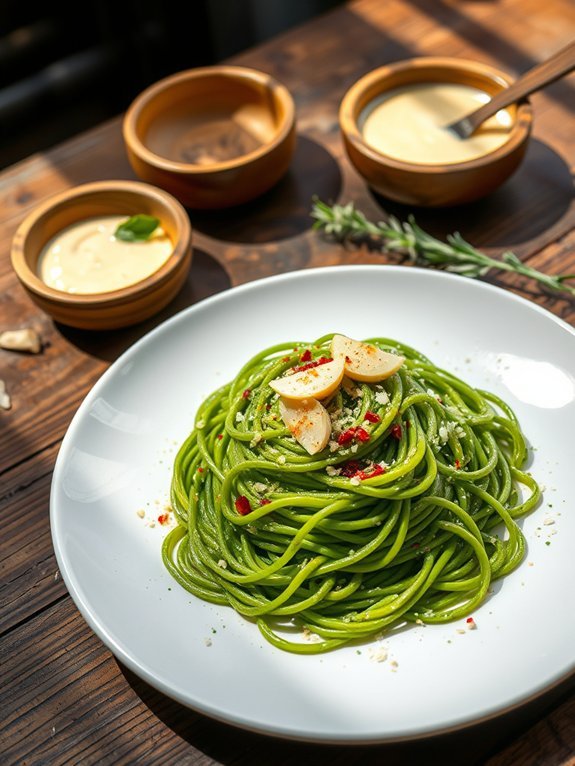
Broccoli noodles are a delightful and nutritious alternative to traditional pasta, making them a perfect fit for those following a low-carb or keto diet. By using broccoli as the base, you not only reduce carbohydrate intake but also boost your meal with vitamins, minerals, and fiber.
The subtle taste of broccoli pairs wonderfully with a variety of sauces, making it a versatile choice that can cater to many culinary styles. Making broccoli noodles is straightforward and can be a fun activity in the kitchen, especially if you’re looking for a quick meal solution.
Steaming or sautéing the broccoli enhances its flavors and allows you to enjoy a dish that feels hearty and filling without the heaviness of carbs. Whether you’re craving a creamy alfredo or a tangy pesto, broccoli noodles are an excellent canvas for your favorite sauces.
- 2 cups of broccoli florets
- 1 tablespoon of olive oil
- 2 cloves of garlic, minced
- Salt and pepper to taste
- Optional toppings: grated Parmesan cheese, crushed red pepper flakes, or fresh herbs
Begin by steaming the broccoli florets for 3-5 minutes until tender but still bright in color. Once cooked, let them cool slightly before using a food processor or blender to pulse them until they resemble noodle shapes.
In a skillet over medium heat, add the olive oil and garlic, cooking until fragrant. Toss in the broccoli noodles, season with salt and pepper, and sauté for an additional 2-3 minutes. Serve warm, topped with your choice of sauce or garnishes.
To enhance the flavor of your broccoli noodles, consider adding a splash of lemon juice or a sprinkle of zest before serving. If you prefer a firmer texture, be careful not to over-process the broccoli, as it can become mushy.
You can also experiment with different seasonings or mix in other vegetables for added color and nutrients, ensuring a dish that isn’t only delicious but also visually appealing.
Proposed Recipe
Kelp Noodles

Kelp noodles are a delightful low-carb alternative to traditional pasta, making them a popular choice for those following a ketogenic diet. These translucent noodles have a unique texture and a mild flavor that absorbs the taste of the sauces and ingredients used in your dish.
Rich in nutrients and low in calories, kelp noodles also provide a great source of iodine and other essential minerals, making them a healthy choice for your meals.
Preparing kelp noodles is incredibly simple and quick, allowing you to whip up a delicious and satisfying meal in no time. While you can enjoy them raw in salads, a quick heat on the stovetop with your favorite sauce or ingredients will enhance their flavor and make for a warming dish. This recipe for sautéed kelp noodles with garlic and vegetables is a perfect way to incorporate these healthy noodles into your diet.
Ingredients:
- 1 package of kelp noodles
- 2 tablespoons olive oil
- 3 cloves garlic, minced
- 1 cup bell peppers, sliced
- 1 cup zucchini, sliced
- 1 cup mushrooms, sliced
- 2 tablespoons soy sauce or tamari (for gluten-free)
- Salt and pepper to taste
- Fresh parsley, chopped (for garnish)
Heat the olive oil in a large skillet over medium heat. Add the minced garlic and sauté for about 30 seconds until fragrant.
Then add the sliced bell peppers, zucchini, and mushrooms. Cook the vegetables for about 5 minutes, until they’re tender.
Rinse the kelp noodles under cold water, then add them to the skillet along with the soy sauce or tamari. Toss everything together and cook for another 2-3 minutes until heated through.
Season with salt and pepper to taste and garnish with fresh parsley before serving.
When cooking kelp noodles, it’s important to remember that they come pre-washed and require minimal cooking. If you find the texture too crunchy for your taste, you can soak them in warm water for 10-15 minutes before cooking to soften them further.
Additionally, feel free to experiment with add-ins like cooked chicken, shrimp, or tofu for added protein, and adjust the seasonings to enhance the flavor further according to your preferences.
Chickpea Pasta
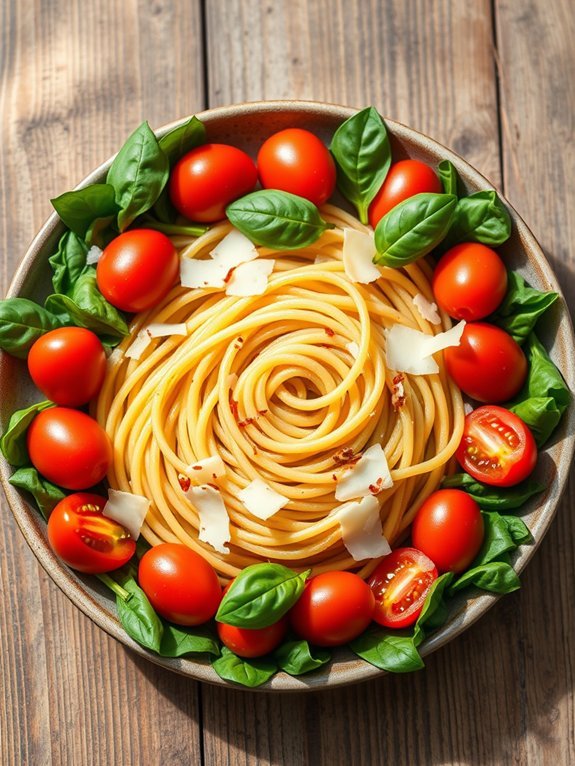
Chickpea pasta is an excellent low-carb alternative for those following a ketogenic or low-carb diet, packing a punch with its nutritional benefits while still satisfying your pasta cravings.
Made from ground chickpeas, this pasta is high in protein and fiber, making it not only a healthier choice than traditional wheat-based pasta but also a filling one that can help sustain your energy throughout the day. Plus, it has a subtle nutty flavor that pairs well with various sauces and toppings, allowing for a versatile meal option.
Cooking with chickpea pasta is straightforward and can be reminiscent of preparing regular pasta dishes. However, there are slight variations in cook time and texture, so being attentive is key. Whether you’re considering a simple olive oil and garlic dish or a heartier sauce, chickpea pasta serves as a robust base that can complement both light and rich flavors alike.
Let’s explore how to cook chickpea pasta to perfection.
Ingredients:
- 8 ounces chickpea pasta
- 2 tablespoons olive oil
- 3 cloves garlic, minced
- 1 teaspoon red pepper flakes (optional)
- 1 cup cherry tomatoes, halved
- 2 cups spinach
- Salt and pepper, to taste
- Fresh basil or parsley, for garnish
- Grated Parmesan cheese (optional)
Cook the chickpea pasta according to the package instructions, usually boiling in salted water for about 7-9 minutes for al dente texture.
In the meantime, heat olive oil in a separate pan over medium heat, then sauté minced garlic until fragrant. Add red pepper flakes, halved cherry tomatoes, and spinach, cooking until the spinach wilts and the tomatoes soften.
Drain the chickpea pasta once cooked, then toss it with the sautéed mixture, adjusting seasoning with salt and pepper. Serve it warm, garnished with fresh herbs and a sprinkle of Parmesan cheese if desired.
When cooking chickpea pasta, it’s important to watch the cooking time closely, as it can become mushy if overcooked. Rinse the pasta under cold water after draining to stop the cooking process if needed.
Additionally, you might want to experiment with different sauces, from marinara to pesto, to find your favorite combination. Keep in mind that chickpea pasta has a different texture than traditional pasta, so don’t be discouraged—embracing this difference can lead to delicious new meal experiences!
Protein Pasta

If you’re following a low-carb or keto diet, you might be missing the comforting sensation of pasta in your meals. Fortunately, protein pasta is a delicious and nutritious alternative. Made primarily from high-protein ingredients like lentils, chickpeas, and various nut flours, protein pasta not only satisfies cravings but also provides an excellent boost to your daily protein intake.
Pair it with your favorite sauces or toppings, and you might just find it becoming a staple in your meal rotation. Cooking protein pasta is simple and can be done in a variety of ways. Similar to traditional pasta, it boils up quickly and takes on flavors beautifully from whatever sauce you choose.
Whether you want to whip up a simple garlic and olive oil dish, a hearty meat sauce, or a fresh veggie medley, protein pasta allows you the flexibility to enjoy your favorite combinations without compromising your dietary goals.
Ingredients:
- 8 ounces protein pasta (such as chickpea or lentil)
- 2 tablespoons olive oil
- 3 cloves garlic, minced
- 1/2 teaspoon red pepper flakes
- 1 cup cherry tomatoes, halved
- 1 cup spinach or kale
- Salt and pepper to taste
- Grated Parmesan cheese for serving (optional)
Bring a large pot of salted water to a boil, and then add the protein pasta, cooking according to the package instructions until al dente.
Meanwhile, in a large skillet, heat the olive oil over medium heat. Add the minced garlic and red pepper flakes, sautéing for 1-2 minutes until fragrant. Incorporate the cherry tomatoes and cook until they begin to soften. Stir in the spinach or kale and cook until wilted.
Once the pasta is done, drain and toss it in the skillet with the vegetables. Season with salt and pepper, then serve warm with a sprinkle of Parmesan cheese if desired.
When cooking protein pasta, be mindful not to overboil it, as it can become mushy faster than traditional pasta. To enhance flavor, consider adding herbs or spices to your cooking water or oil. You can also experiment with different protein pasta shapes or brands, as they may have unique flavors and textures that can elevate your dish.
Finally, don’t be afraid to get creative with sauces and toppings to keep your meals exciting and satisfying on your keto journey!

